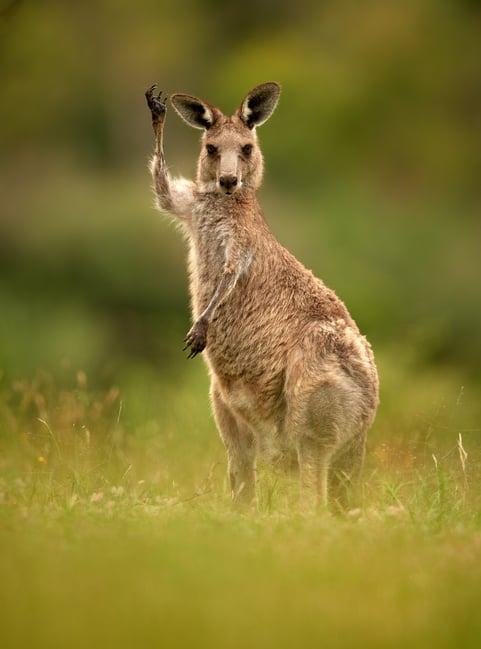At times, wildlife photography can feel strictly descriptive: a bird on a stick, a giraffe on the savannah, a butterfly on a flower, and so on. Nothing wrong with that – most of the photos I take fall into that category. Still, when I can, I try to find moments that tell more of a story of the animal. Humor is one of the best, and least expected, tools to do so. But if you keep your eyes open and your mind cheerful, opportunities to make you laugh will surely come your way as a wildlife photographer.

I photographed this waving kangaroo in eastern Australia seven years ago. Of course, its friendly gesture is not what it seems. The kangaroo was just coating his forearms with saliva to cool off. At the moment it applied some of its saliva to its ears, I pulled the trigger. The result is a photograph that makes him look like he’s saying hello!
Wildlife photos with humor can be not only fun to look at, but commercially successful. Some of my favorite photography competitions are the wildlife comedy awards, like those hosted by Nikon and other groups. Even my kangaroo photo was “Highly Commended” in Nature’s Best Photography International Awards. If you want to get more eyes on your wildlife photos, making them humorous is not a bad approach!
And here’s another example of humor in wildlife photography. You may not know it unless you’re a wildlife photographer, but hummingbirds are notoriously grouchy and intolerant creatures. You certainly can’t expect them to French kiss when they meet on a branch. Although the true nature of this image is rather different, depicting territorial behavior and a fight for a food source, I think the photo could be used as a Valentine’s Day card.

Even insects can put a smile on your face. Again, it takes some imagination and a sense of humor. When I took this photo of a praying mantis – a serious, even deadly serious insect – I can imagine that it’s scratching its chin. “Hmm… what goodie would I like for dinner?

On rare occasions, animals make me laugh so hard that I’m almost unable to photograph them. This family of sleeping Australian Apostlebirds looked like office workers resting after a very long week. They were able to stay on the branch only because of a special physiological adaptation of their tendons and muscles that prevents them from falling off, even when they’re zonked out. Another member of the flock even lay down on the ground beneath a tree. And believe it or not, he even slept on his back for a while! I strained my ears to hear snoring.

About ten meters away from the tree with the Apostlebirds, another scene was taking place at the same time. A Blue-faced Honeyeater was completely ignoring the sign warning that the water from this tap was undrinkable! Doesn’t it know how to read?

Much of the time, the humorous emotions captured in wildlife photos are just us humans projecting our own emotions onto the subject. It’s not like the bird above was really aware of the irony of its situation, or the kangaroo from earlier actually waving at me. But sometimes, I think that the emotions of the subjects are very clear and add to the photo’s humor. Like in this picture of a Cassowary sneaking a bite to eat.

The Cassowary is a large bird that can command the respect of humans. Especially when it understands that humans are an unlimited source of good food. Trying to shoo away an uninvited guest at your table can easily end with a painful kick in the stomach. Have you ever seen the claw the Cassowary has for such occasions? The natives of Papua New Guinea used it as a dagger. But when it sneaks some food like this, it reminds me of an audacious dog or cat grabbing a bit off my dinner plate!
Finally, some animals, like this Dark-backed Wood-quail from Ecuador, don’t need to do anything special in order to be humorous. They just need to step into view. In this case, the combination of a round body, oversized legs, and a face that resembles a Venetian Medico della Peste mask is hilarious. Sorry, Woodquail. I love you even though you’re goofy.

As a wildlife photographer, I recommend that you keep an eye out for humor wherever you go. In the best case, you may get a photo that steals the show at a wildlife comedy photo contest. But even if that doesn’t come to pass, a funny photo is one that grabs attention. People who view your photos will feel the story of the image. It will stick with them for longer and help brighten their mood, which is a worthy goal to have any time you are taking pictures.
There are several thoughts that can be shared with other species on this earth. We have so much in common with each other. I enjoy visiting with artists and photographers work because they bring out the true beauty of life.
Loved the photos and your commentary. Thanks for the smles.
You have captured just outstanding stuff and it makes me laugh and makes me smile. Makes me feel good thank you.
Nature gives me Hope
The one in the group of 4 birds asleep that has it’s head thrown back is like every guy in our family after Thanksgiving dinner. Still laughing! Excellent shutter work (enviable, even) and good eye.
Great narrative!
Very nice.
I love each wildlife picture you have shared.
Thank you for the laughter this early morning. God bless you to continue on your journey.
The Kangaroo looks like he was on an Aitcraft Carrier guiding the jets on and off the ship. Perfect form.
Great Photography, I think you must spend many hours of work and enjoyment . Thank you for your photographs for us to enjoy.